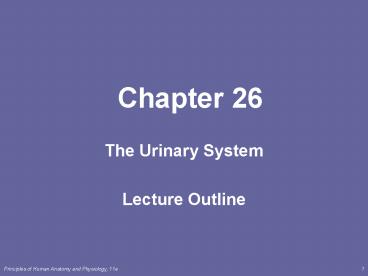The Urinary System PowerPoint PPT Presentation
1 / 23
Title: The Urinary System
1
Chapter 26
- The Urinary System
- Lecture Outline
2
INTRODUCTION
- Study of the structure, function, and diseases of
the kidneys is nephrology. The branch of surgery
related to the urinary system is called urology. - The urinary system helps maintain homeostasis by
- Altering blood composition, pH, volume, and
pressure - Maintaining blood osmolarity
- Excreting wastes
- Producing hormones
- Regulates ions in our blood, like Na, K, Ca2,
and Cl-
3
Components
- The urinary system consists of 2 kidneys, 2
ureters, 1 bladder, and 1 urethra. - The main function of the kidneys is to filter the
blood and produce urine. - Urine is made up of water and solutes removed
from our blood.
4
External Anatomy of Kidney
- Paired kidney-bean-shaped organ
- 4-5 in long, 2-3 in wide,1 in thick
- Found just above the waist between the peritoneum
posterior wall of abdomen
5
Internal Anatomy of the Kidney
- The outside of a kidney is called the renal
cortex and is reddish brown in color. - The inside of a kidney is called the renal
medulla.
6
Nephrons
- The functional unit of a kidney is a nephron
- There are millions of nephrons found in each of
your kidneys.
7
Nephron Anatomy
- Blood enters the kidney through the glomerulus
which is a ball of capillaries. - It is surrounded by a protective capsule called
the Bowmans capsule. - Blood is filtered here and then moves on to the
rest of the nephron.
8
Nephron Anatomy
- Blood then goes through the proximal tubule, down
the descending Loop of Henle, up the ascending
Loop of Henle, and through the distal tubule. - At each step, the nephron is removing useful
things from blood, like water, nutrients,
minerals, and salts that were absorbed by the
digestive system.
9
Nephron Anatomy
- After going through the nephron, all thats left
is waste. - The waste is collected in the collecting duct and
sent to the ureter to travel to the bladder for
storage.
10
Urine
- You produce 1 to 2 liters of urine every 24
hours. - Urine should be clear to pale yellow in color.
- Urine should be transparent (clear)
- It is mildly aromatic and smells like ammonia
when left standing - pH of urine ranges from 4.6 to 8.0, with an
average of 6.0 - 95 of urine is water, the remaining 5 is
electrolytes, salts, and drugs. - There should never be protein in your urine
11
The Bladder
- The bladder is a hollow, stretchable muscular
organ located in the pelvic cavity. - Urinary bladder capacity ranges from 700-800mL,
slightly less in females because of the uterus
12
Urethra
- The urethra is a small tube leading from the
bladder to the exterior of the body. - In men, it also carries sperm.
13
Development of the Urinary system
- By week 3 of pregnancy, kidneys begin to form
- Fetuses go through 3 pairs of kidneys before
birth, only the last one remains at the time of
birth - By month 3, fetuses begin producing urine, which
remains in the amniotic fluid
14
Aging and the Urinary System
- After age 40, the effectiveness of kidney
function begins to decrease. - Kidneys shrink
- Filters less effectively, you are more thirsty
- Diseases and infections are more common
- Cancer of prostate is common in elderly men
15
Diseases and Disorders
- Nephroptosis or floating kidney, is an inferior
displacement or dropping of the kidney. - Common in thin people who dont have enough fat
to hold the kidney in place. - Its dangerous because it may block urine flow.
16
Diseases and Disorders
- Glucosuria is when you have too much glucose in
your blood for the kidney to filter (common in
diabetics) - Some glucose then remains in the urine causing
increased urinary output, decreased blood volume,
and dehydration.
17
Diseases and Disorders
- Diuretics are substances that slow renal
reabsorption of water and cause elevated urine
flow. - These include coffee, tea, soda, and alcohol.
- These all inhibit the secretion of ADH and cause
you to pee more.
18
Diseases and Disorders
- During cytoscopy a small camera is inserted
through the urethra into the bladder and/or
prostate. - The bladder can be visually inspected and tissue
samples can be collected
19
Diseases and Disorders
- In urinary incontinence you no longer have
control over your bladder muscles and pee leaks
out. - This is common in small children and older
adults. - It can also be caused by physical stress on the
bladder (lifting heavy things, sneezing,
laughing, being pregnant)
20
Diseases and Disorders
- Kidney stones are insoluble salt crystals that
lodge in the ureter. - Causes include poor diet, not enough water, or
too much calcium - They can be dissolved through sending high energy
shock waves through the body
21
Diseases and Disorders
- A UTI is a urinary tract infection.
- They are caused by bacteria getting into the
urethra and are more common in females because
they have shorter urethras. - Symptoms include painful or burning urination and
low back pain - Cured by antibiotics
22
Diseases and Disorders
- Renal failure is when the nephrons in your
kidneys either decrease in function or stop
working. - Can be caused by illness or injury, drugs, or low
blood pressure. - Dialysis and kidney transplant are possible
treatments.
23
Draw a Kidney
- Use page 996 as a reference
- Include a picture and labels of important
structures. - Must be colored
- Due at the end of the period

